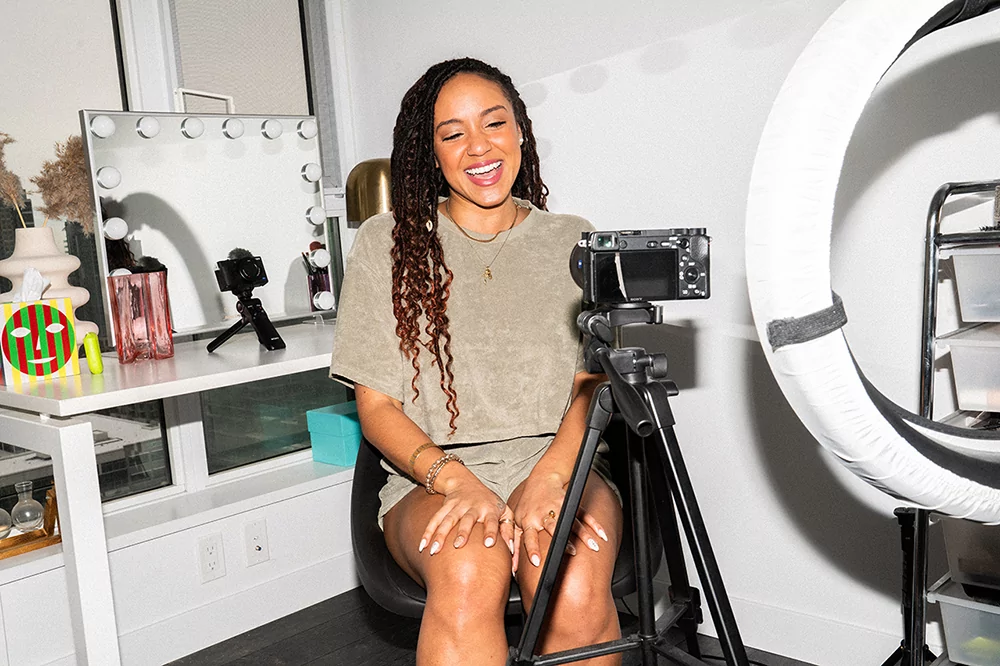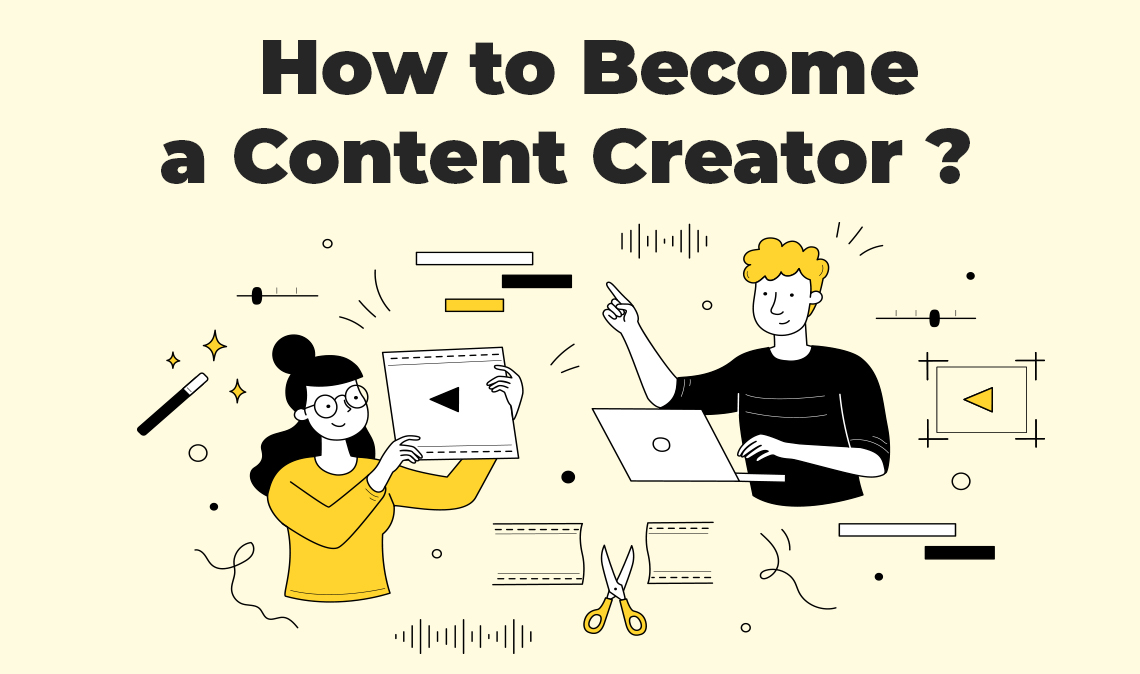In today’s digital age, the world of content creation has blossomed into a realm of infinite possibilities. From videos and blogs to podcasts and social media posts, content creators play a pivotal role in shaping online narratives and influencing audiences worldwide. If you’re eager to dive into this dynamic field and make your mark as a content creator in 2024, this blog post is your guide to getting started and thriving in the digital content landscape.
What is a content creator?

A content creator is an individual who produces and publishes various forms of content across digital platforms. This content can include written articles, blog posts, videos, podcasts, social media posts, infographics, and more. Content creators are responsible for generating engaging and informative materials that resonate with their target audience and convey a specific message, story, or idea.
Content creators play a crucial role in today’s digital landscape, where online platforms are flooded with information. They have the ability to capture attention, evoke emotions, educate, entertain, and even influence opinions. The content they produce can range from entertainment and lifestyle content to educational, informational, or promotional content related to a particular niche or industry.
Different aspects of a content creator’s role

Key aspects of a content creator’s role include:
Creative Ideation: Content creators generate fresh and creative ideas for their content, considering the preferences and interests of their audience.
Content Production: They create content in various formats, such as writing articles, filming videos, recording podcasts, or designing graphics.
Editing and Enhancing: Content creators refine and edit their work to ensure it is clear, engaging, and aligned with their intended message.
Platform Management: They decide which platforms (websites, social media, video-sharing sites, etc.) are best suited for their content and manage the distribution accordingly.
Audience Engagement: Content creators interact with their audience by responding to comments, addressing feedback, and fostering discussions around their content.
Consistency: Maintaining a consistent content schedule is important to keep the audience engaged and attract new followers.
Innovation: Content creators need to adapt to changing trends, technologies, and audience preferences to stay relevant and maintain their audience’s interest.
Content creators can be independent freelancers, bloggers, vloggers, social media influencers, or professionals working within a larger organization’s marketing or communication departments. Their content serves diverse purposes, including entertainment, education, marketing, advocacy, or simply sharing personal experiences.
In recent years, the rise of digital platforms and social media has democratized content creation, allowing individuals from all walks of life to share their perspectives, talents, and expertise with a global audience. As a result, content creators have become powerful voices in shaping public discourse, promoting products and services, and creating engaging online communities.
Different types of content creators

Content creators come in various forms, each specializing in different types of content and catering to specific platforms and audiences. Here are some of the different types of content creators:
Blogger: Bloggers write and publish articles or posts on a personal or professional blog. They often share their thoughts, expertise, experiences, and opinions on various topics.
Vlogger: Vloggers (video bloggers) create video content typically shared on platforms like YouTube. They often document their daily lives, share tutorials, reviews, travel experiences, and more through video format.
Podcaster: Podcasters produce audio content that is distributed through podcast platforms. They host discussions, interviews, storytelling, and informational content that listeners can stream or download.
Social Media Influencer: Social media influencers build a following on platforms like Instagram, TikTok, Twitter, and more. They share a variety of content, including lifestyle, fashion, beauty, fitness, travel, and more, often promoting products or services to their audience.
Photographer: Photographers create visual content through captivating images. They may focus on various genres, such as fashion, landscape, portrait, food, or event photography.
Graphic Designer: Graphic designers create visual content using digital tools. They design logos, infographics, illustrations, and other visual assets for websites, social media, and marketing materials.
YouTuber: YouTubers specifically create and upload video content to YouTube. They cover a wide range of topics, including entertainment, education, technology, gaming, and more.
Twitch Streamer: Twitch streamers live-stream video content, often while playing video games or engaging in discussions. They interact with their audience in real-time through chat and donations.
Ebook Author: Ebook authors create longer-form written content in the form of ebooks, which can be self-published or released through various platforms.
Animator: Animators create animated content, including short films, cartoons, explainer videos, and more, using animation software and techniques.
Food Blogger/YouTuber: Content creators who specialize in sharing recipes, cooking tips, and food-related content through blog posts, videos, and social media.
Travel Blogger/Vlogger: Individuals who document their travel experiences, share destination guides, travel tips, and cultural insights through written articles, videos, and photographs.
Educational Content Creator: These creators focus on producing informative and educational content on subjects like science, history, technology, self-improvement, and more.
Fashion and Beauty Influencer: These influencers specialize in showcasing fashion trends, makeup tutorials, skincare routines, and styling tips through visual content on platforms like Instagram and YouTube.
Fitness Influencer: Fitness influencers share workout routines, diet tips, and healthy living advice through videos, posts, and stories on social media.
DIY/Craft Creator: Creators who produce content related to do-it-yourself (DIY) projects, crafts, and home improvement, often sharing tutorials and step-by-step guides.
These are just a few examples of the diverse roles that content creators can take on. As digital platforms continue to evolve, new types of content creators emerge, contributing to the rich and varied landscape of online content.
How much money can a content creator make?

The income potential for a content creator can vary significantly based on several factors, including the type of content they create, the platforms they use, their audience size and engagement, the niche they operate in, and their monetization strategies. Here’s a breakdown of how content creators can make money and the potential income ranges:
Ad Revenue on Platforms:
YouTube: Content creators on YouTube can earn money through Google AdSense by monetizing their videos with ads. Earnings depend on factors like video views, audience demographics, ad engagement, and ad formats. Estimated earnings can range from a few dollars to thousands per month.
TikTok: TikTok creators can participate in the TikTok Creator Fund, where they receive a share of the ad revenue generated from their videos. Earnings depend on video views and engagement.
Sponsorships and Brand Collaborations:
Content creators can partner with brands to promote products or services in their content. Earnings vary based on the brand’s budget, the creator’s reach and engagement, and the nature of the collaboration. Influencers with larger audiences and higher engagement rates can earn substantial amounts from sponsored content.
Affiliate Marketing:
Content creators can promote affiliate products or services through unique tracking links. They earn a commission for each sale or conversion generated through their links. Earnings depend on the products promoted, the creator’s audience, and the effectiveness of their marketing efforts.
Merchandise Sales:
Many content creators sell branded merchandise such as clothing, accessories, or digital products. Earnings depend on the popularity of the creator and the demand for their merchandise.
Paid Memberships/Subscriptions:
Some platforms, like Patreon, allow content creators to offer premium content to subscribers in exchange for a monthly fee. Creators can earn recurring revenue from their dedicated fan base.
Content Licensing:
Content creators may license their work to other platforms, publishers, or media outlets. Photographers, writers, and videographers can earn money by licensing their content for commercial use.
Freelance Work:
Content creators with specialized skills may offer their services on freelance platforms or through their websites. Writers, designers, photographers, and videographers can earn income by taking on client projects.
Donations and Tips:
Some platforms allow fans to donate or tip content creators directly. Creators with loyal and supportive audiences can earn extra income through donations.
It’s important to note that content creator income can be unpredictable and may not be consistent from month to month. Additionally, building a substantial audience and generating significant income typically takes time, dedication, and consistent effort. While some content creators achieve substantial earnings, others may earn more modest amounts. Ultimately, a content creator’s income potential depends on their ability to create high-quality content, engage their audience, and effectively monetize their platform and niche.
12 Steps to become a successful content creator

1. Find Your Passion and Niche
The first step on your journey to becoming a content creator is discovering what truly ignites your passion. Whether it’s beauty, travel, gaming, technology, or personal development, identify a niche that resonates with you and aligns with your interests and expertise.
2. Understand Your Audience
Creating content is all about connecting with your audience. Conduct thorough research to understand your target audience’s preferences, challenges, and aspirations. This knowledge will guide your content creation process and help you deliver content that resonates with them.
3. Choose Your Platforms
The digital world offers an array of platforms for content distribution. Consider where your target audience spends most of their time and choose platforms accordingly. This could include YouTube, Instagram, TikTok, blogs, podcasts, or a combination of these.
4. Develop Your Content Strategy
A well-defined content strategy is the backbone of a successful content creator’s journey. Plan the type of content you’ll create, the frequency of posting, and how you’ll maintain consistency. Your strategy should align with your goals and resonate with your audience.
5. Invest in Quality Equipment
While you don’t need the most expensive equipment to start, investing in good-quality gear is essential. A reliable camera, microphone, and editing software can significantly enhance the production value of your content.
6. Create Engaging Content
Captivating content is the heart of content creation. Whether it’s entertaining, informative, inspiring, or educational, aim to create content that leaves a lasting impact on your audience. Focus on storytelling and visuals that keep viewers engaged.
7. Consistency is Key
Consistency is crucial in building a loyal audience. Set a regular posting schedule and stick to it. Consistency not only keeps your audience engaged but also boosts your credibility as a content creator.
8. Collaborate and Network
Collaborating with fellow content creators can expand your reach and introduce you to new audiences. Networking within your niche can lead to valuable partnerships, insights, and growth opportunities.
9. Embrace Learning and Improvement
The digital landscape is ever-evolving. Stay updated with the latest trends, tools, and techniques in content creation. Continuously seek to improve your skills, whether it’s video editing, photography, writing, or communication.
10. Engage with Your Audience
Interact with your audience through comments, direct messages, and social media engagement. Building a strong community around your content fosters a sense of connection and loyalty.
11. Be Patient and Persistent
Becoming a successful content creator takes time. Don’t be discouraged by slow growth initially. Stay persistent, keep refining your content, and remember that every successful creator started from scratch.
12. Be Authentic
Above all, authenticity is your greatest asset. Your unique perspective, voice, and personality are what set you apart. Don’t be afraid to showcase your true self in your content.
How to start content creation as a side hustle

Starting content creation as a side hustle is a great way to explore your creative interests and potentially earn some extra income.
Here’s a step-by-step guide to help you get started:
Choose Your Niche:
Decide on the type of content you want to create. This could be writing, video creation, podcasting, photography, graphic design, or any other form that aligns with your skills and interests.
Identify Your Audience:
Define your target audience. Who are you creating content for? Understanding your audience’s preferences, interests, and needs will help you tailor your content to their preferences.
Select Your Platforms:
Choose the platforms where you’ll share your content. This could be a blog, YouTube, Instagram, TikTok, a podcast hosting platform, or other relevant platforms for your niche.
Research and Plan:
Research similar content creators in your niche. What topics do they cover? How do they engage their audience? Use this information to plan your own content strategy.
Create a Content Calendar:
Create a content calendar that outlines the topics, formats, and publishing schedule for your content. Consistency is key to building an audience.
Start Creating:
Begin creating your content. Whether it’s writing blog posts, filming videos, recording podcasts, or designing graphics, focus on providing value to your audience.
Focus on Quality:
While you’re starting as a side hustle, aim for high-quality content. This will help you stand out and attract a loyal audience.
Promote Your Content:
Share your content on social media platforms, relevant forums, and any other online communities where your target audience hangs out.
Engage with Your Audience:
Respond to comments, messages, and feedback from your audience. Building a community around your content is essential for growth.
Monetization Strategies:
As your content gains traction, explore monetization strategies such as affiliate marketing, sponsored content, or selling digital products related to your niche.
Stay Patient and Consistent:
Content creation takes time to yield results. Be patient and stay consistent with your efforts, even if you’re not seeing immediate success.
Measure and Adjust:
Keep an eye on your content’s performance. Use analytics to understand what’s resonating with your audience and adjust your strategy accordingly.
Time Management:
Since you’re starting as a side hustle, manage your time effectively. Set aside dedicated time for content creation while balancing it with your primary responsibilities.
Continuous Learning:
Stay updated with trends in your niche and keep refining your content creation skills. Learning and improving will help you attract a larger audience.
Remember, content creation as a side hustle is a journey. It may take time before you see substantial income or audience growth, so focus on enjoying the process and learning along the way. As you gain experience and build your audience, you can explore the possibility of transitioning into content creation as a more significant source of income if you choose.
Conclusion
In recent years, the world of content creation continues to offer exciting opportunities for creative expression and meaningful impact. By embracing your passion, honing your skills, and connecting with your audience, you can embark on a fulfilling journey as a content creator and leave your mark on the digital landscape.



